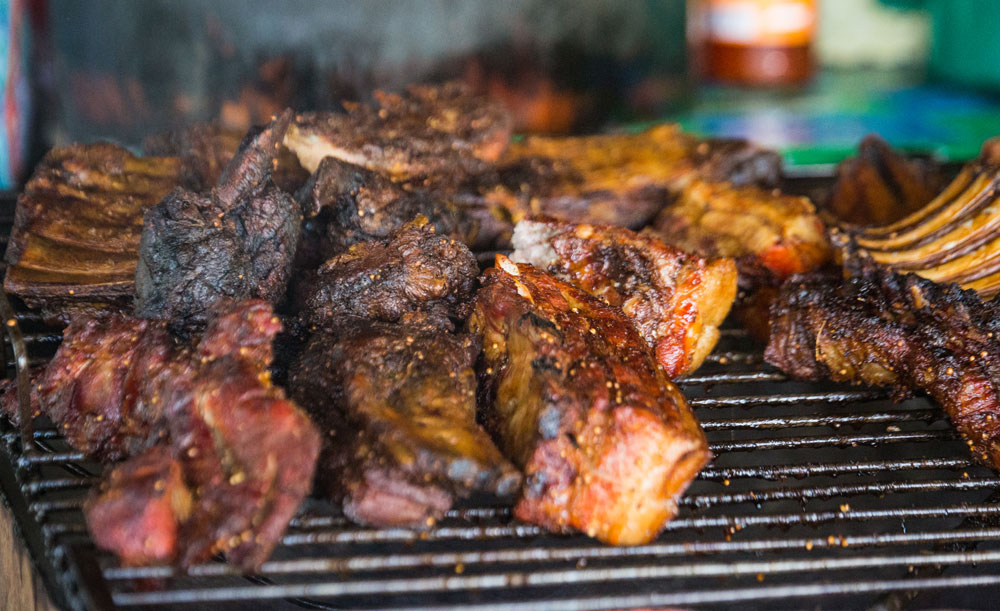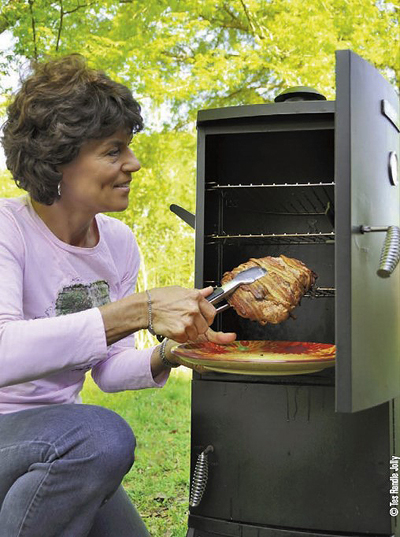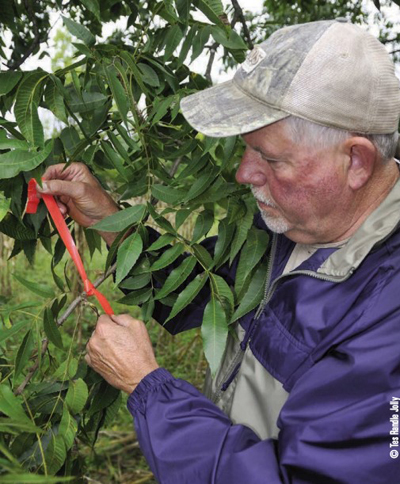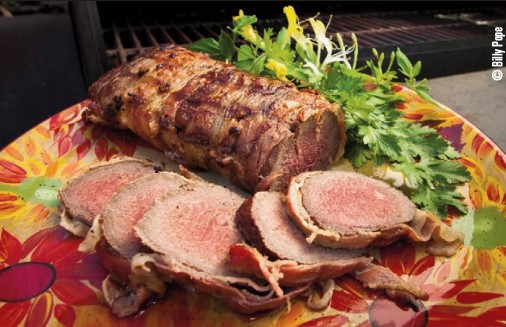Ron Jolly | Originally published in GameKeepers: Farming for Wildlife Magazine

Anyone who has ever smelled the aroma of a loaded grill knows the attraction. The tantalizing smell of roasting meat stirs us all. Perhaps that smell was one of the attractions that enticed humans to fireside gatherings eons ago. Possibly the anticipation of the meal forthcoming was the main attraction. Either way, cooking food on an open fire has become an art form shared by millions of people. Most of us no longer depend on gathered wood to heat our grills. Instead, we use prepared fuel in the form of charcoal. Nobody knows what ancient man called open fire cooking. Today we call it Barbeque!
Turn your meat when the bacon on top of meat top begins to sweat and bacon on bottom has turned brown. Use a meat thermometer and take meat off grill when it reaches 160 degrees in the center.
The Flavor is in the Wood!

technique of smoking food you will be eager to share your
culinary skills with friends such as grilled venison
medallions. Soon your grill will be the center of attraction.
Meat and vegetables seasoned and cooked over charcoal are delicious. There are special rubs and marinades specifically blended for wild game, beef, poultry, pork, and fish. Each rub and marinade is comprised of a combination of herbs, spices, salt and/or sugar to enhance the meat or vegetable. The drippings from meat cooking over charcoal add flavor, but if you really want to alter and enhance the taste of food on a grill, add real wood for smoking meat.
Wood, specifically hardwood, smokes as it burns. Each hardwood specie yields smoke with a unique aroma. As the meat or vegetable cooks, the smoke emitted from the wood is absorbed further enhancing its flavor.
There are three methods commonly used to infuse smoke flavor into meats and vegetables. The first method is called “cold smoking.” Cold smoking does not cook foods but the smoke flavor is added to the food to be cooked later. Cold smoked foods assume the flavor of the smoke and remain moist. Good choices for cold smoking are chicken breasts, wild turkey, pork chops, steaks, salmon and scallops. Smoking temperatures should be maintained at or below 100 degrees Fahrenheit.
The second method is “Hot Smoking”. This method exposes food to smoke and heat in a controlled environment. Cooking temperatures should remain between 165 and 185 degrees Fahrenheit. Foods hot smoked are typically safe to eat without further cooking. Hams, chickens, roasts, venison and briskets are excellent for hot smoking. Hot smoked meats typically shrink because the grease and fat is cooked away. The remaining meat is moist, tender and succulent.
The third method, and my favorite, is “grill smoking.” This method utilizes indirect heat to cook the meat or vegetables. It requires a grill with two compartments, one for the fire and one for the food. I use charcoal as fuel and add hardwood chunks soaked in water to add the smoke. Temperatures should remain between 250 and 300 degrees Fahrenheit. The draft from the fire box to the smoke stack draws heat and smoke over the meat cooking and flavoring it in the process. This method is excellent for pork ribs, wild pork, chicken halves, brisket and fish.
Wild Game
When you think of a gamekeeper and the “gamekeeper lifestyle,” the first thing that comes to mind is the animals we work so hard to manage. Deer and turkeys top the list on our small Alabama farm. Every land management decision we make is implemented with deer and turkeys in mind. But to us, the return on our investment is more than a trophy for the wall. The meat from a deer, turkey or wild hog is as prized as antlers, beards or tusks.
Smoking wild game is different than smoking domestic meat. Game meat is leaner than domestic meat and requires a different approach.

and smoke over the meat, cooking and flavoring it in the
process.
There are two ways to insure wild game will be tender and moist after smoking:
1. Make a brine
- Mix 3 quarts water
- One quart apple juice
- ½ cup soy sauce
- ¼ cup Worcestershire Sauce
- ½ cup brown sugar
- ½ cup molasses
- 1 tbs rosemary
- 2 tbs black pepper
Place cuts of venison or wild pork that have been trimmed of all the silver-skin, fat and connective tissue in a shallow pan. Mix ingredients and pour the brine over the meat. Place the soaking meat in the refrigerator for at least 12 hours. Turn the meat over every two hours.
Remove the meat from the brine and bring to room temperature. Secure strips of bacon on one side of meat with toothpicks. Grill smoke the meat (indirect heat) at 300 degrees until meat reaches 160 degrees at the bone. This works great with venison and wild pork hams. I like mesquite wood for this smoke.
2. Use a marinade.
- 1 venison or wild pork backstrap (loin)—all silver-skin removed
- 1 cup marinad ¼ cup olive oil
- 1 tbs. minced fresh garlic Juice from
- ½ fresh lemon
- 2 tbs. coarsely ground black pepper
- 1 tbs. rosemary
- 1 lb thin sliced bacon
Mix marinade, olive oil and all seasonings in a gallon Ziploc bag or a container with a lid. Place meat in marinade and place in refrigerator for six hours. Remove meat from marinade and completely wrap meat in bacon using toothpicks to hold bacon in place. Let meat come to room temperature (approximately 1 hour). Grill smoke meat at 280 degrees until meat reaches 160 degrees internally. Turn meat when bacon on top of meat top begins to sweat and bacon on bottom has turned brown. Use meat thermometer and take meat off grill when meat reaches 160 degrees in center.
Popular Woods for Smoking Meat
Without a doubt, hickory is the most widely used wood for smoking meat east of the Mississippi River. Mesquite is popular in the west in addition to regional favorites across the country. Availability is part of the attraction, but the unique taste added to anything smoked no doubt adds to the popularity. As previously stated, most any hardwood will add a unique flavor to your grilled foods.
Wood for smoking in chunks, chips and pellet form is available at most grocery outlets and big box stores. More exotic types are available through online ordering. The downside to buying wood for smoking meat is it can be expensive. To save money I locate, cut and cure my own smoking wood.

tape. Once he locates a tree for smoke wood he attaches
tape to the tree. The tree species is written on the tape
since cutting will occur during winter after leaf drop.
Depending on your region, there are local woods available to make your next grilled meal a culinary delight. If you are not familiar with different tree species in your area take a tree identification book into the field. I carry a saw, pruning shears, and surveyor’s tape. Once I locate a tree for “smoke wood” I attach tape to the tree. The tree species is written on the tape since cutting will occur during winter after leaf drop. Once the tree is down I trim small branches away and store the wood in a dry place. When dry, I cut it to the desired length. Large pieces are split to desired size with an axe.
Smoking No-No’s
While almost any hardwood will serve you well for smoking food there are some woods that you should never use. Never use any processed wood for smoking meat. Things like particle board, plywood, and pressed board. These processed woods are held together with glue and chemicals that can be very harmful if ingested. Never use softwoods like pine, cedar, poplar, willow or cottonwood. Never use wood that has been painted or treated with chemicals. Finally, never use wood that is mildewed or covered with fungus even if it is natural. Only use wood that you know is in its natural state!
Happy Smoking!
No matter how you choose to smoke food; cold, hot or grill; hickory, apple or mesquite, your food will taste better for the effort. Just remember to experiment and learn as you go. Variables such as type of cooker, size of cooker, amount of smoke applied and the seasoning you use will all factor in the end product’s taste. Start small. That way if you do not like a particular smoke flavor you have not invested a lot of food in the experiment. Take your time! Getting the perfect amount of smoke on food is a process, not a single action.
Practice makes perfect! Once you have mastered the technique of smoking food you will be eager to share your culinary skills with friends. Soon your grill will be the center of attraction.
Which Wood Do I Use?
Certain hardwoods are better with certain meats. They compliment the natural flavor of that meat and it is important to know which to use when smoking meat. Here are some hardwoods commonly used to add smoke flavor to meat.
- Acacia—This wood is similar to mesquite but not as strong. It burns hot and should be used in small quantities for a limited time. Good with most meats.
- Alder—A light flavor that works well with fish and poultry. It is the traditional wood for smoking salmon.
- Almond—Adds a nutty, sweet flavor that is good with all meats.
- Apple—Very mild flavor and gives meat a sweetness. Good with poultry and pork. Apricot—Similar to hickory but is sweeter and milder. Good with poultry and pork.
- Ash—Burns fast and has a light unique flavor. Good with most meats.
- Black Walnut—Heavy flavor that can be bitter. Better paired with a mild smoke wood.
- Birch—Good with poultry and pork. Similar to maple in taste.
- Cherry—Sweet, mild flavor that goes well with almost all meats. One of the most popular woods for smoking meat.
- Citrus—Woods like lemon and orange have a moderate smoke that gives light fruity flavor. Good with most meats.
- Cottonwood—Very mild and should be used with stronger flavored woods.
- Crabapple—Similar to apple wood and is excellent with poultry and pork.
- Grapefruit—Tart smoke that gives a fruity but heavy flavor. Use sparingly with poultry and lamb.
- Hickory—Popular smoking wood for most foods. Excellent with wild game, beef and lamb. Strong flavor so do not use excessively.
- Lemon—Good with any meat. Mild smoky flavor.
- Maple—Mild sweet flavor great with poultry and pork.
- Mesquite—Burns hot and fast. Strong flavored wood that is good with pork and poultry.
- Mulberry—Sweet, mild flavor. Similar to apple.
- Nectarine—Similar to hickory but milder in flavor. Great with poultry and pork.
- Oak—Strong, but not overpowering. Great with wild game, beef and lamb.
- Peach—Similar to hickory but milder and sweeter in flavor. Great with poultry and pork.
- Pear—Similar to apple. Sweet, mild flavor and good with most meats.
- Pecan—Provides a mild nutty flavor. A mild version of hickory.
- Plum—Similar to hickory but sweeter and milder. Great for poultry and pork.
- Walnut—Heavy, smoky flavor and should be mixed with a milder flavored wood.

Remember, smoking meat is a process, not a single action. The amount of smoke flavor is determined by the amount of time the meat is exposed to the smoke, so experiment. Use different types of wood soaked in water and vary the amount of time your meat is exposed to the smoke. Soon you will have a formula that produces the smoke flavor you prefer!

Need wild game meat for a recipe you've been wanting to try? Check out GameKeeper Butchery. GameKeeper Butchery is dedicated to procuring the finest assortment and highest quality of specialty meats from the United States and around the world. Our commitment is to deliver the safest, freshest and most wholesome products.






























